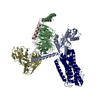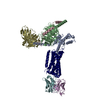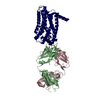+ Open data
Open data
- Basic information
Basic information
| Entry | Database: PDB / ID: 8hs2 | ||||||||||||||||||||||||||||||||||||||||||||||||||||||
|---|---|---|---|---|---|---|---|---|---|---|---|---|---|---|---|---|---|---|---|---|---|---|---|---|---|---|---|---|---|---|---|---|---|---|---|---|---|---|---|---|---|---|---|---|---|---|---|---|---|---|---|---|---|---|---|
| Title | Orphan GPR20 in complex with Fab046 | ||||||||||||||||||||||||||||||||||||||||||||||||||||||
 Components Components |
| ||||||||||||||||||||||||||||||||||||||||||||||||||||||
 Keywords Keywords | MEMBRANE PROTEIN / Complex / GPR20 / GPCR / orphan / orphan receptor / class-A | ||||||||||||||||||||||||||||||||||||||||||||||||||||||
| Function / homology |  Function and homology information Function and homology informationelectron transport chain / G protein-coupled receptor activity / G alpha (s) signalling events / electron transfer activity / periplasmic space / receptor complex / iron ion binding / G protein-coupled receptor signaling pathway / heme binding / plasma membrane Similarity search - Function | ||||||||||||||||||||||||||||||||||||||||||||||||||||||
| Biological species |    Homo sapiens (human) Homo sapiens (human) | ||||||||||||||||||||||||||||||||||||||||||||||||||||||
| Method | ELECTRON MICROSCOPY / single particle reconstruction / cryo EM / Resolution: 3.08 Å | ||||||||||||||||||||||||||||||||||||||||||||||||||||||
 Authors Authors | Lin, X. / Jiang, S. / Xu, F. | ||||||||||||||||||||||||||||||||||||||||||||||||||||||
| Funding support | 1items
| ||||||||||||||||||||||||||||||||||||||||||||||||||||||
 Citation Citation |  Journal: Cell Discov / Year: 2023 Journal: Cell Discov / Year: 2023Title: The activation mechanism and antibody binding mode for orphan GPR20. Authors: Xi Lin / Shan Jiang / Yiran Wu / Xiaohu Wei / Gye-Won Han / Lijie Wu / Junlin Liu / Bo Chen / Zhibin Zhang / Suwen Zhao / Vadim Cherezov / Fei Xu /   Abstract: GPR20 is a class-A orphan G protein-coupled receptor (GPCR) and a potential therapeutic target for gastrointestinal stromal tumors (GIST) owing to its differentially high expression. An antibody-drug ...GPR20 is a class-A orphan G protein-coupled receptor (GPCR) and a potential therapeutic target for gastrointestinal stromal tumors (GIST) owing to its differentially high expression. An antibody-drug conjugate (ADC) containing a GPR20-binding antibody (Ab046) was recently developed in clinical trials for GIST treatment. GPR20 constitutively activates Gi proteins in the absence of any known ligand, but it remains obscure how this high basal activity is achieved. Here we report three cryo-EM structures of human GPR20 complexes including Gi-coupled GPR20 in the absence or presence of the Fab fragment of Ab046 and Gi-free GPR20. Remarkably, the structures demonstrate a uniquely folded N-terminal helix capping onto the transmembrane domain and our mutagenesis study suggests a key role of this cap region in stimulating the basal activity of GPR20. We also uncover the molecular interactions between GPR20 and Ab046, which may enable the design of tool antibodies with enhanced affinity or new functionality for GPR20. Furthermore, we report the orthosteric pocket occupied by an unassigned density which might be essential for exploring opportunities for deorphanization. | ||||||||||||||||||||||||||||||||||||||||||||||||||||||
| History |
|
- Structure visualization
Structure visualization
| Structure viewer | Molecule:  Molmil Molmil Jmol/JSmol Jmol/JSmol |
|---|
- Downloads & links
Downloads & links
- Download
Download
| PDBx/mmCIF format |  8hs2.cif.gz 8hs2.cif.gz | 154.1 KB | Display |  PDBx/mmCIF format PDBx/mmCIF format |
|---|---|---|---|---|
| PDB format |  pdb8hs2.ent.gz pdb8hs2.ent.gz | 115.2 KB | Display |  PDB format PDB format |
| PDBx/mmJSON format |  8hs2.json.gz 8hs2.json.gz | Tree view |  PDBx/mmJSON format PDBx/mmJSON format | |
| Others |  Other downloads Other downloads |
-Validation report
| Summary document |  8hs2_validation.pdf.gz 8hs2_validation.pdf.gz | 1.2 MB | Display |  wwPDB validaton report wwPDB validaton report |
|---|---|---|---|---|
| Full document |  8hs2_full_validation.pdf.gz 8hs2_full_validation.pdf.gz | 1.2 MB | Display | |
| Data in XML |  8hs2_validation.xml.gz 8hs2_validation.xml.gz | 31.8 KB | Display | |
| Data in CIF |  8hs2_validation.cif.gz 8hs2_validation.cif.gz | 46 KB | Display | |
| Arichive directory |  https://data.pdbj.org/pub/pdb/validation_reports/hs/8hs2 https://data.pdbj.org/pub/pdb/validation_reports/hs/8hs2 ftp://data.pdbj.org/pub/pdb/validation_reports/hs/8hs2 ftp://data.pdbj.org/pub/pdb/validation_reports/hs/8hs2 | HTTPS FTP |
-Related structure data
| Related structure data |  34983MC  8hs3C  8hscC M: map data used to model this data C: citing same article ( |
|---|---|
| Similar structure data | Similarity search - Function & homology  F&H Search F&H Search |
- Links
Links
- Assembly
Assembly
| Deposited unit | 
|
|---|---|
| 1 |
|
- Components
Components
| #1: Antibody | Mass: 26493.723 Da / Num. of mol.: 1 Source method: isolated from a genetically manipulated source Source: (gene. exp.)   |
|---|---|
| #2: Antibody | Mass: 25637.654 Da / Num. of mol.: 1 Source method: isolated from a genetically manipulated source Source: (gene. exp.)   |
| #3: Protein | Mass: 50631.012 Da / Num. of mol.: 1 / Mutation: L139W,D293N Source method: isolated from a genetically manipulated source Source: (gene. exp.)   Homo sapiens (human) Homo sapiens (human)Gene: cybC, GPR20 / Production host:  |
| Has protein modification | Y |
-Experimental details
-Experiment
| Experiment | Method: ELECTRON MICROSCOPY |
|---|---|
| EM experiment | Aggregation state: PARTICLE / 3D reconstruction method: single particle reconstruction |
- Sample preparation
Sample preparation
| Component | Name: The complex of GPR20 with Fab046 / Type: COMPLEX / Entity ID: all / Source: MULTIPLE SOURCES |
|---|---|
| Source (natural) | Organism:  Homo sapiens (human) Homo sapiens (human) |
| Source (recombinant) | Organism:  |
| Buffer solution | pH: 7.5 |
| Specimen | Embedding applied: NO / Shadowing applied: NO / Staining applied: NO / Vitrification applied: YES |
| Vitrification | Cryogen name: ETHANE |
- Electron microscopy imaging
Electron microscopy imaging
| Experimental equipment |  Model: Titan Krios / Image courtesy: FEI Company |
|---|---|
| Microscopy | Model: FEI TITAN KRIOS |
| Electron gun | Electron source: OTHER / Accelerating voltage: 300 kV / Illumination mode: OTHER |
| Electron lens | Mode: BRIGHT FIELD / Nominal defocus max: 2200 nm / Nominal defocus min: 700 nm |
| Image recording | Electron dose: 60 e/Å2 / Film or detector model: GATAN K3 (6k x 4k) |
- Processing
Processing
| Software | Name: PHENIX / Version: 1.20.1_4487: / Classification: refinement | ||||||||||||||||||||||||
|---|---|---|---|---|---|---|---|---|---|---|---|---|---|---|---|---|---|---|---|---|---|---|---|---|---|
| EM software | Name: PHENIX / Category: model refinement | ||||||||||||||||||||||||
| CTF correction | Type: NONE | ||||||||||||||||||||||||
| 3D reconstruction | Resolution: 3.08 Å / Resolution method: FSC 0.143 CUT-OFF / Num. of particles: 418288 / Symmetry type: POINT | ||||||||||||||||||||||||
| Refine LS restraints |
|
 Movie
Movie Controller
Controller





 PDBj
PDBj













